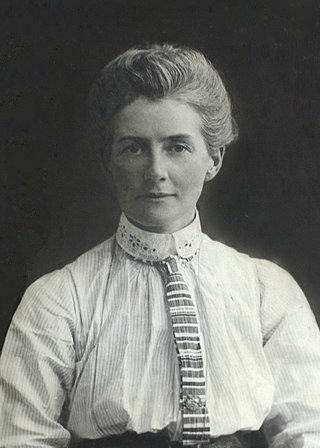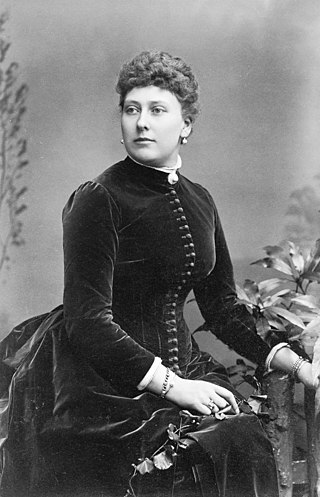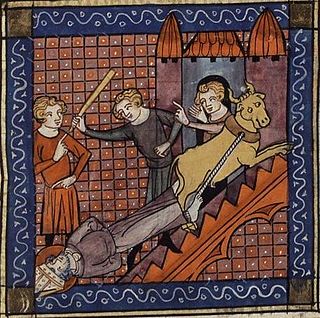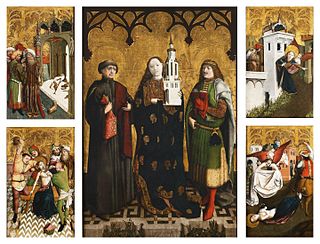Related Research Articles

Victoria Caroline Beckham is an English fashion designer, singer, and television personality. She rose to prominence in the 1990s as a member of the pop group the Spice Girls, in which she was nicknamed Posh Spice. With over 100 million records sold worldwide, the group became the best-selling female group of all time. After the Spice Girls disbanded in 2001, Beckham signed with Virgin Records, to release her self-titled debut solo album, which produced two UK Top 10 singles. Beckham has also become an internationally recognised style icon and fashion designer.

Edith Louisa Cavell was a British nurse. She is celebrated for treating wounded soldiers from both sides without discrimination during the First World War and for helping some 200 Allied soldiers escape from German-occupied Belgium. Cavell was arrested, court-martialled under German military law and sentenced to death by firing squad. Despite international pressure for mercy, the German government refused to commute her sentence, and she was shot. The execution received worldwide condemnation and extensive press coverage.

The Lamentable Tragedy of Titus Andronicus, often shortened to Titus Andronicus, is a tragedy by William Shakespeare, believed to have been written between 1588 and 1593. It is thought to be Shakespeare's first tragedy and is often seen as his attempt to emulate the violent and bloody revenge plays of his contemporaries, which were extremely popular with audiences throughout the 16th century.

Catherine of Alexandria, also spelled Katherine is, according to tradition, a Christian saint and virgin, who was martyred in the early 4th century at the hands of the emperor Maxentius. According to her hagiography, she was both a princess and a noted scholar who became a Christian around age 14, converted hundreds of people to Christianity, and was martyred around age 18. More than 1,100 years after Catherine's martyrdom, Joan of Arc identified her as one of the saints who appeared to and counselled her.

Hilary of Poitiers was Bishop of Poitiers and a Doctor of the Church. He was sometimes referred to as the "Hammer of the Arians" and the "Athanasius of the West". His name comes from the Latin word for happy or cheerful. In addition to his important work as bishop, Hilary was married and the father of Abra of Poitiers, a nun and saint who became known for her charity.

Princess Beatrice, later Princess Henry of Battenberg, was the fifth daughter and youngest child of Queen Victoria and Prince Albert. Beatrice was also the last of Queen Victoria's children to die, nearly 66 years after the first, her elder sister Alice.

Saturnin of Toulouse was one of the "Apostles to the Gauls" sent out during the consulate of Decius and Gratus (250–251) to Christianise Gaul after the persecutions under Emperor Decius had all but dissolved the small Christian communities. Fabian sent out seven bishops from Rome to Gaul to preach the Gospel: Gatien to Tours, Trophimus to Arles, Paul to Narbonne, Saturnin to Toulouse, Denis to Paris, Austromoine to Clermont, and Martial to Limoges. His feast day is 29 November.

Titus is a 1999 epic surrealist historical drama film written, co-produced, and directed by Julie Taymor in her feature directorial debut, based on William Shakespeare's tragedy Titus Andronicus. A co-production between Italy, the United Kingdom, and the United States, the film stars Anthony Hopkins in the title role of Titus Andronicus, the Roman army general, chronicling his downfall following a victorious return from war. It was produced by Overseas Filmgroup and Clear Blue Sky Productions and released by Fox Searchlight Pictures.

February 10 - Eastern Orthodox liturgical calendar - February 12

Victoria or Nao Victoria was a carrack famed as the first ship to successfully circumnavigate the world. Victoria was part of the Spanish expedition to the Moluccas commanded by the explorer Ferdinand Magellan.

The Martyrs of Córdoba were forty-eight Christian martyrs who were executed under the rule of Muslim administration in Al-Andalus. The hagiographical treatise written by the Iberian Christian and Latinist scholar Eulogius of Córdoba describes in detail the executions of the martyrs for capital violations of Islamic law (sharīʿa), including apostasy and blasphemy. The martyrdoms recorded by Eulogius took place between 850 and 859 AD, which according to the Mālikī judges of al-Andalus broke the treaty signed between Muslims and their Christian subjects.

Julia Nikolayevna Obertas, married name: Horak is a former pair skater who represented Ukraine until 2000 and then Russia until the end of her career. She is best known for her partnership with Sergei Slavnov, with whom she competed from 2003 to 2007. They are the 2005 European silver medalists. Earlier, she competed with Alexei Sokolov for Russia and Dmytro Palamarchuk for Ukraine. With Palamarchuk, she became a two-time (1998–1999) World Junior champion.

Felicitas of Rome, also anglicized as Felicity, is a saint numbered among the Christian martyrs. Apart from her name, the only thing known for certain about this martyr is that she was buried in the Cemetery of Maximus, on the Via Salaria on a 23 November. However, a legend presents her as the mother of the seven martyrs whose feast is celebrated on 10 July. The Eastern Orthodox Church celebrates their martyrdom on 25 January.

Capital punishment in Australia has been abolished in all jurisdictions since 1985. Queensland abolished the death penalty in 1922. Tasmania did the same in 1968. The Commonwealth abolished the death penalty in 1973, with application also in the Australian Capital Territory and the Northern Territory. Victoria did so in 1975, South Australia in 1976, and Western Australia in 1984. New South Wales abolished the death penalty for murder in 1955, and for all crimes in 1985. In 2010, the Commonwealth Parliament passed legislation prohibiting the re-establishment of capital punishment by any state or territory. Australian law prohibits the extradition or deportation of a prisoner to another jurisdiction if they could be sentenced to death for any crime.
The Order of Saint Barbara is a military honor society of the US for both the US Army and the US Marine Corps Artillery, including Field Artillery and Air Defense Artillery.
The Martyrs of Abitinae were a group of 49 Christians found guilty, in 304, during the reign of the Emperor Diocletian, of having illegally celebrated Sunday worship at Abitinae, a town in the Roman province of Africa. The town is frequently referred to as Abitina, but the form indicated in the Annuario Pontificio is Abitinae. The plural form Abitinae is that which Saint Augustine of Hippo used when writing his De baptismo in 400 or 401.

Engratia is venerated as a virgin martyr and saint. Tradition states that she was martyred with eighteen companions in 303 AD.

Saint Barbara, known in the Eastern Orthodox Church as the Great Martyr Barbara, was an early Christian Greek saint and martyr. There is no reference to her in the authentic early Christian writings nor in the original recension of Saint Jerome's martyrology.

Perpetua and Felicity were Christian martyrs of the third century. Vibia Perpetua was a recently married, well-educated noblewoman, said to have been 22 years old at the time of her death, and mother of an infant son she was nursing. Felicity, a slave woman imprisoned with her and pregnant at the time, was martyred with her. They were put to death along with others at Carthage in the Roman province of Africa.
The witch trials in Connecticut, also sometimes referred to as the Hartford witch trials, occurred from 1647 to 1663. They were the first large-scale witch trials in the American colonies, predating the Salem Witch Trials by nearly thirty years. John M. Taylor lists a total of 37 cases, 11 of which resulted in executions. The execution of Alse Young of Windsor in the spring of 1647 was the beginning of the witch panic in the area, which would not come to an end until 1670 with the release of Katherine Harrison.
References
- ↑ "Maria Stein Center - Shrine of the Holy Relics". Archived from the original on 2007-10-12. Retrieved 2007-10-09.
- ↑ "Patron Saints Index: Saint Victoria". Archived from the original on 2011-07-08. Retrieved 2007-10-09.
- 1 2 3 Latin Saints of the Orthodox Patriarchate of Rome